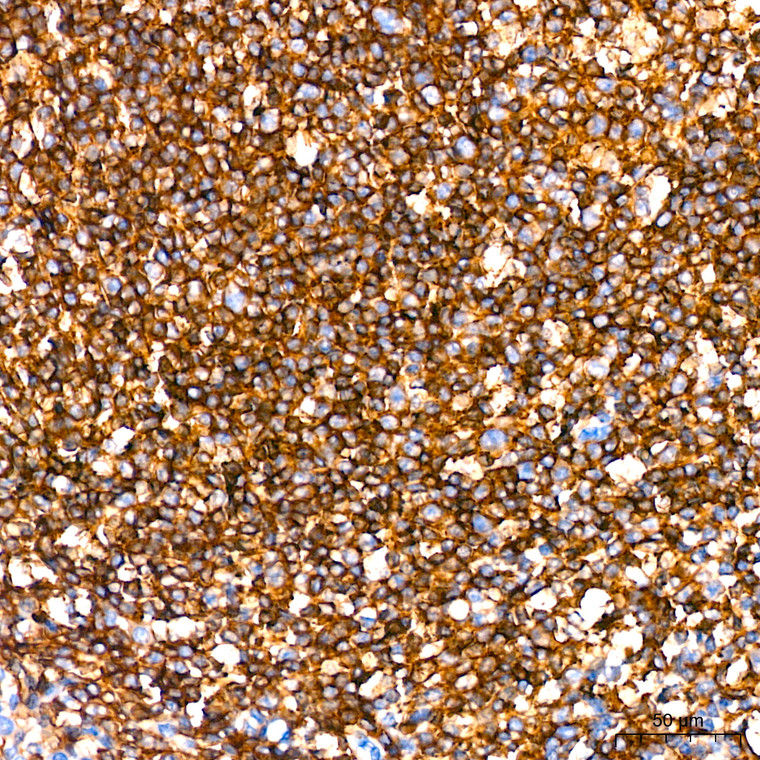| Host: |
Rabbit |
| Applications: |
WB/IHC |
| Reactivity: |
Human/Mouse/Rat |
| Note: |
STRICTLY FOR FURTHER SCIENTIFIC RESEARCH USE ONLY (RUO). MUST NOT TO BE USED IN DIAGNOSTIC OR THERAPEUTIC APPLICATIONS. |
| Short Description: |
Rabbit monoclonal antibody anti-Leptin Receptor (1000-1100) is suitable for use in Western Blot and Immunohistochemistry research applications. |
| Clonality: |
Monoclonal |
| Clone ID: |
S3MR |
| Conjugation: |
Unconjugated |
| Isotype: |
IgG |
| Formulation: |
PBS with 0.02% Sodium Azide, 0.05% BSA, 50% Glycerol, pH7.3. |
| Purification: |
Affinity purification |
| Dilution Range: |
WB 1:500-1:1000IHC-P 1:50-1:200 |
| Storage Instruction: |
Store at-20°C for up to 1 year from the date of receipt, and avoid repeat freeze-thaw cycles. |
| Gene Symbol: |
LEPR |
| Gene ID: |
3953 |
| Uniprot ID: |
LEPR_HUMAN |
| Immunogen Region: |
1000-1100 |
| Immunogen: |
A synthetic peptide corresponding to a sequence within amino acids 1000-1100 of human Leptin Receptor (P48357). |
| Immunogen Sequence: |
EEQGLINSSVTKCFSSKNSP LKDSFSNSSWEIEAQAFFIL SDQHPNIISPHLTFSEGLDE LLKLEGNFPEENNDKKSIYY LGVTSIKKRESGVLLTDKSR V |
| Tissue Specificity | Isoform A is expressed in fetal liver and in hematopoietic tissues and choroid plexus. In adults highest expression in heart, liver, small intestine, prostate and ovary. Low level in lung and kidney. Isoform B is highly expressed in hypothalamus, but also in skeletal muscle. Detected in fundic and antral epithelial cells of the gastric mucosa. Isoform B and isoform A are expressed by NK cells (at protein level). |
| Post Translational Modifications | On ligand binding, phosphorylated on two conserved C-terminal tyrosine residues (isoform B only) by JAK2. Tyr-986 is required for complete binding and activation of PTPN11, ERK/FOS activation,for interaction with SOCS3 and SOCS3 mediated inhibition of leptin signaling. Phosphorylation on Tyr-1141 is required for STAT3 binding/activation. Phosphorylation of Tyr-1079 has a more accessory role. |
| Function | Receptor for hormone LEP/leptin (Probable). On ligand binding, mediates LEP central and peripheral effects through the activation of different signaling pathways such as JAK2/STAT3 and MAPK cascade/FOS. In the hypothalamus, LEP acts as an appetite-regulating factor that induces a decrease in food intake and an increase in energy consumption by inducing anorexinogenic factors and suppressing orexigenic neuropeptides, also regulates bone mass and secretion of hypothalamo-pituitary-adrenal hormones. In the periphery, increases basal metabolism, influences reproductive function, regulates pancreatic beta-cell function and insulin secretion, is pro-angiogenic and affects innate and adaptive immunity. Control of energy homeostasis and melanocortin production (stimulation of POMC and full repression of AgRP transcription) is mediated by STAT3 signaling, whereas distinct signals regulate NPY and the control of fertility, growth and glucose homeostasis. Involved in the regulation of counter-regulatory response to hypoglycemia by inhibiting neurons of the parabrachial nucleus. Has a specific effect on T lymphocyte responses, differentially regulating the proliferation of naive and memory T -ells. Leptin increases Th1 and suppresses Th2 cytokine production. Isoform A: May transport LEP across the blood-brain barrier. Binds LEP and mediates LEP endocytosis. Does not induce phosphorylation of and activate STAT3. Isoform E: Antagonizes Isoform A and isoform B-mediated LEP binding and endocytosis. |
| Protein Name | Leptin ReceptorLep-RHub219Ob ReceptorOb-RCd Antigen Cd295 |
| Database Links | Reactome: R-HSA-2586552 P48357-1 |
| Cellular Localisation | Cell MembraneSingle-Pass Type I Membrane ProteinBasolateral Cell MembraneIsoform E: Secreted |
| Alternative Antibody Names | Anti-Leptin Receptor antibodyAnti-Lep-R antibodyAnti-Hub219 antibodyAnti-Ob Receptor antibodyAnti-Ob-R antibodyAnti-Cd Antigen Cd295 antibodyAnti-LEPR antibodyAnti-DB antibodyAnti-OBR antibody |
Information sourced from Uniprot.org
12 months for antibodies. 6 months for ELISA Kits. Please see website T&Cs for further guidance










